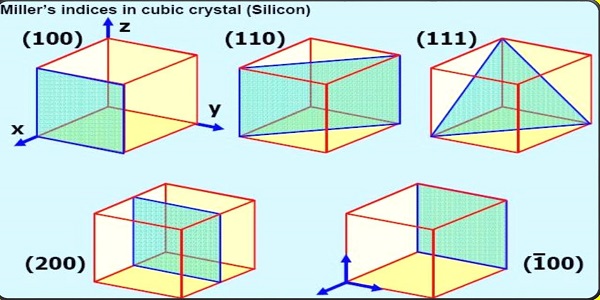What is a Lattice Plane?
In crystallography, a lattice plane of a given Bravais lattice is a plane (or family of parallel planes) whose intersections with the lattice (or any crystalline structure of that lattice) are periodic (i.e. are described by 2d Bravais lattices) and intersect the Bravais lattice; equivalently, a lattice plane is any plane containing at least three noncollinear Bravais lattice points. All lattice planes can be described by a set of integer Miller indices, and vice versa (all integer Miller indices define lattice planes).
What are Miller Indices?
Miller indices form a notation system in crystallography for planes in crystal (Bravais) lattices.
In particular, a family of lattice planes is determined by three integers h, k, and ℓ, the Miller indices. They are written (hkℓ), and denote the family of planes orthogonal to , where are the basis of the reciprocal lattice vectors (note that the plane is not always orthogonal to the linear combination of direct lattice vectors because the lattice vectors need not be mutually orthogonal). By convention, negative integers are written with a bar, as in 3 for −3. The integers are usually written in lowest terms, i.e. their greatest common divisor should be 1. Miller indices are also used to designate reflections in X-ray crystallography. In this case the integers are not necessarily in lowest terms, and can be thought of as corresponding to planes spaced such that the reflections from adjacent planes would have a phase difference of exactly one wavelength (2π), regardless of whether there are atoms on all these planes or not.
There are also several related notations:
- the notation {hkℓ} denotes the set of all planes that are equivalent to (hkℓ) by the symmetry of the lattice.
In the context of crystal directions (not planes), the corresponding notations are:
- [hkℓ], with square instead of round brackets, denotes a direction in the basis of the direct lattice vectors instead of the reciprocal lattice; and
- similarly, the notation <hkℓ> denotes the set of all directions that are equivalent to [hkℓ] by symmetry.
Miller indices were introduced in 1839 by the British mineralogist William Hallowes Miller, although an almost identical system (Weiss parameters) had already been used by German mineralogist Christian Samuel Weiss since 1817.The method was also historically known as the Millerian system, and the indices as Millerian, although this is now rare.
The Miller indices are defined with respect to any choice of unit cell and not only with respect to primitive basis vectors, as is sometimes stated.




